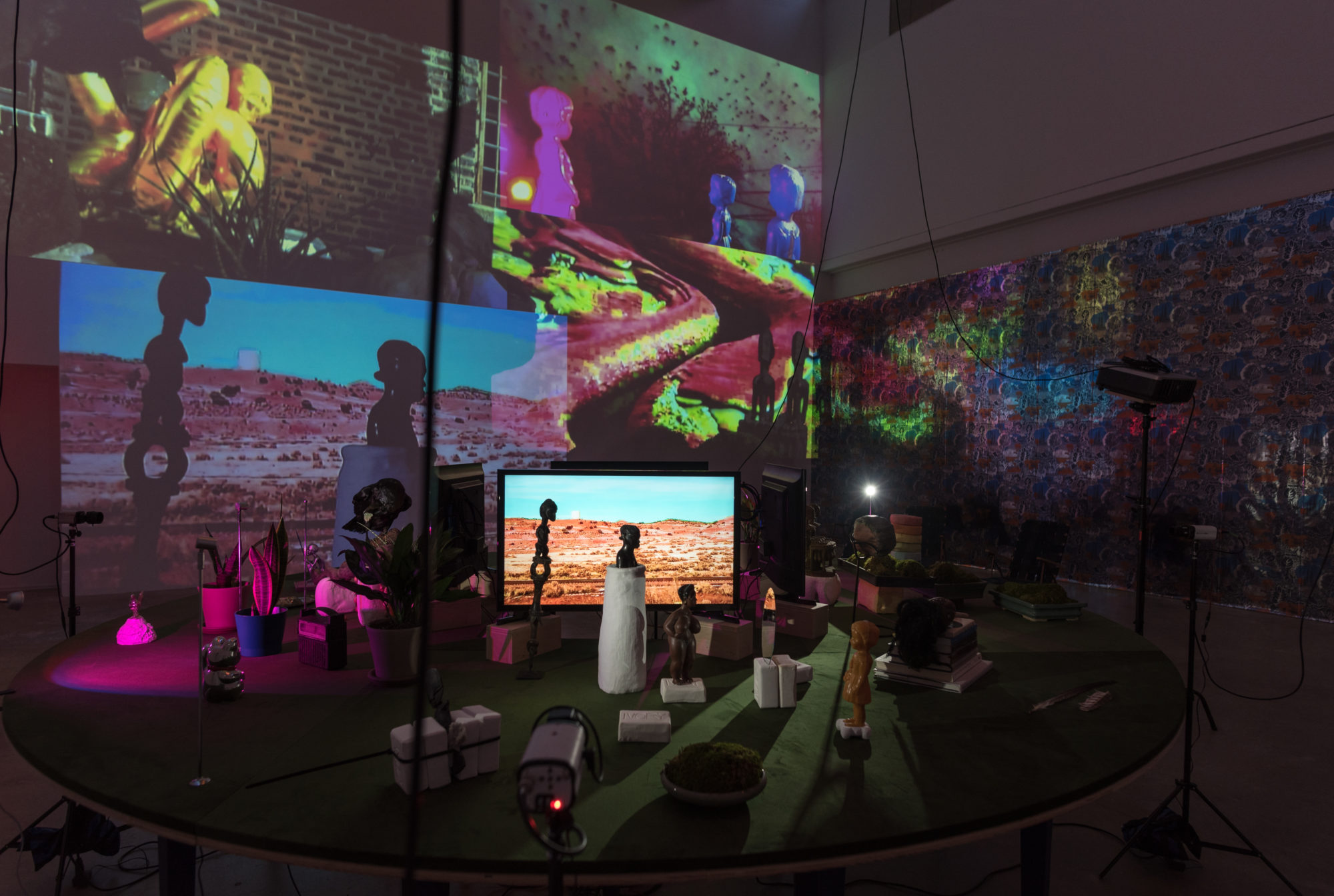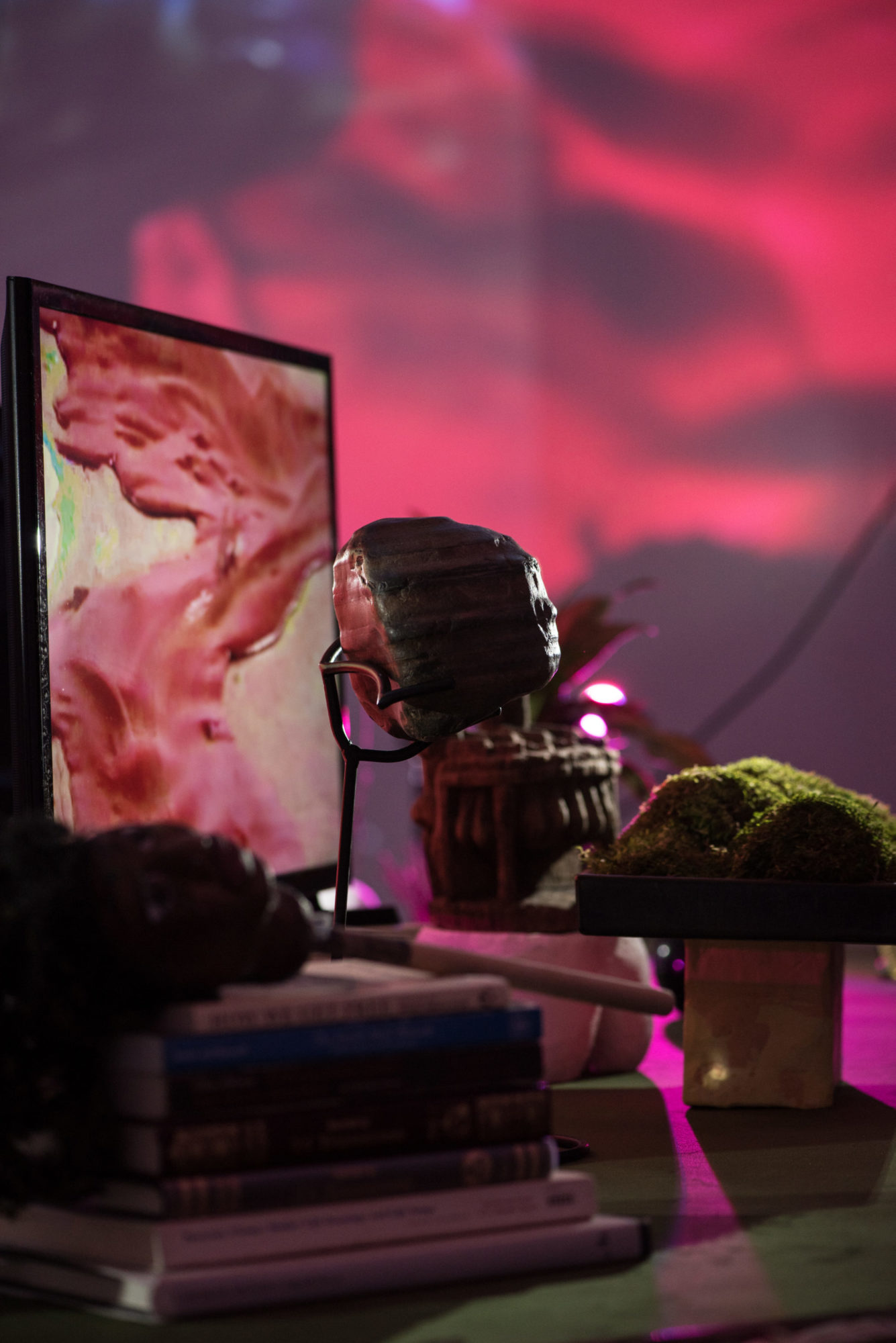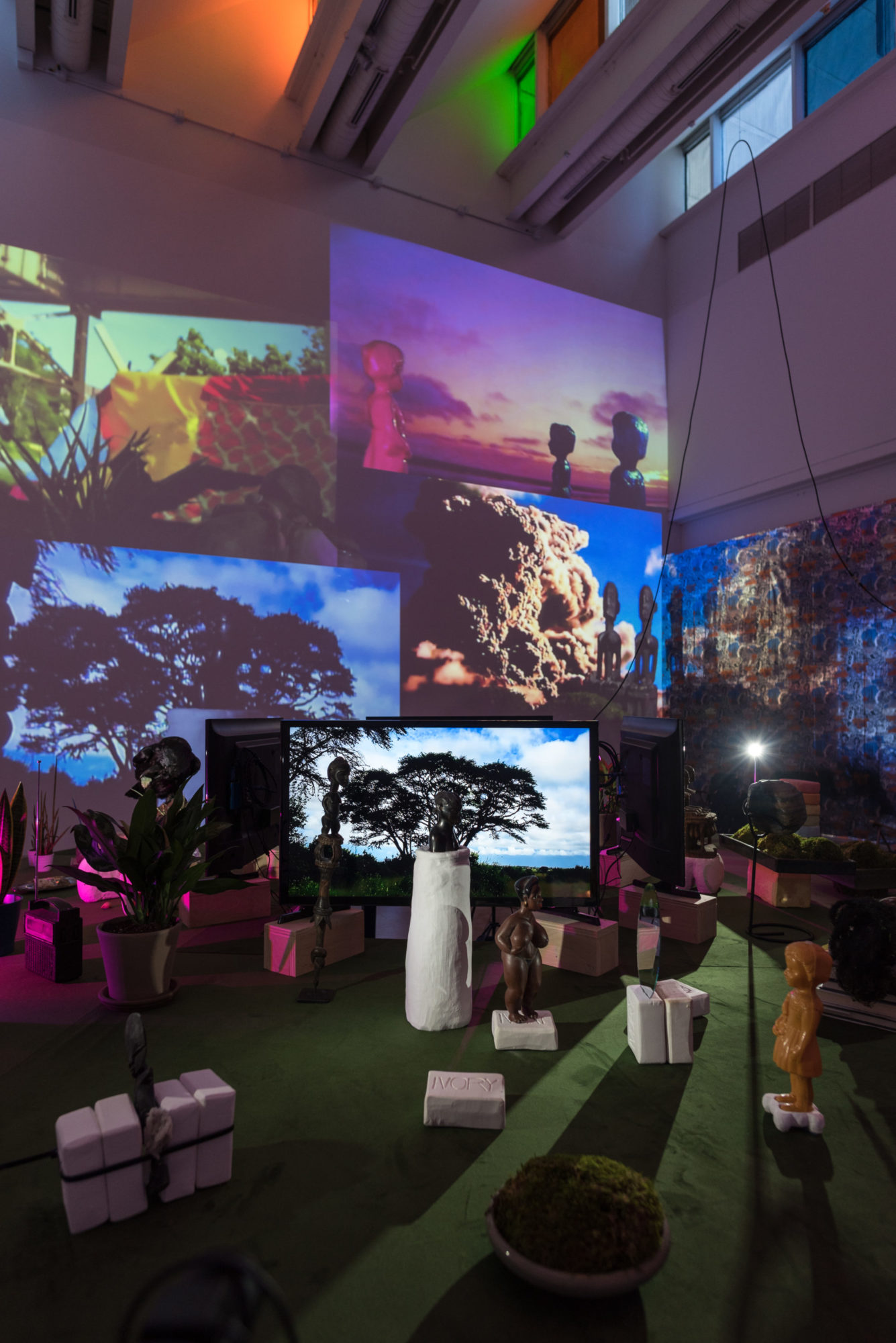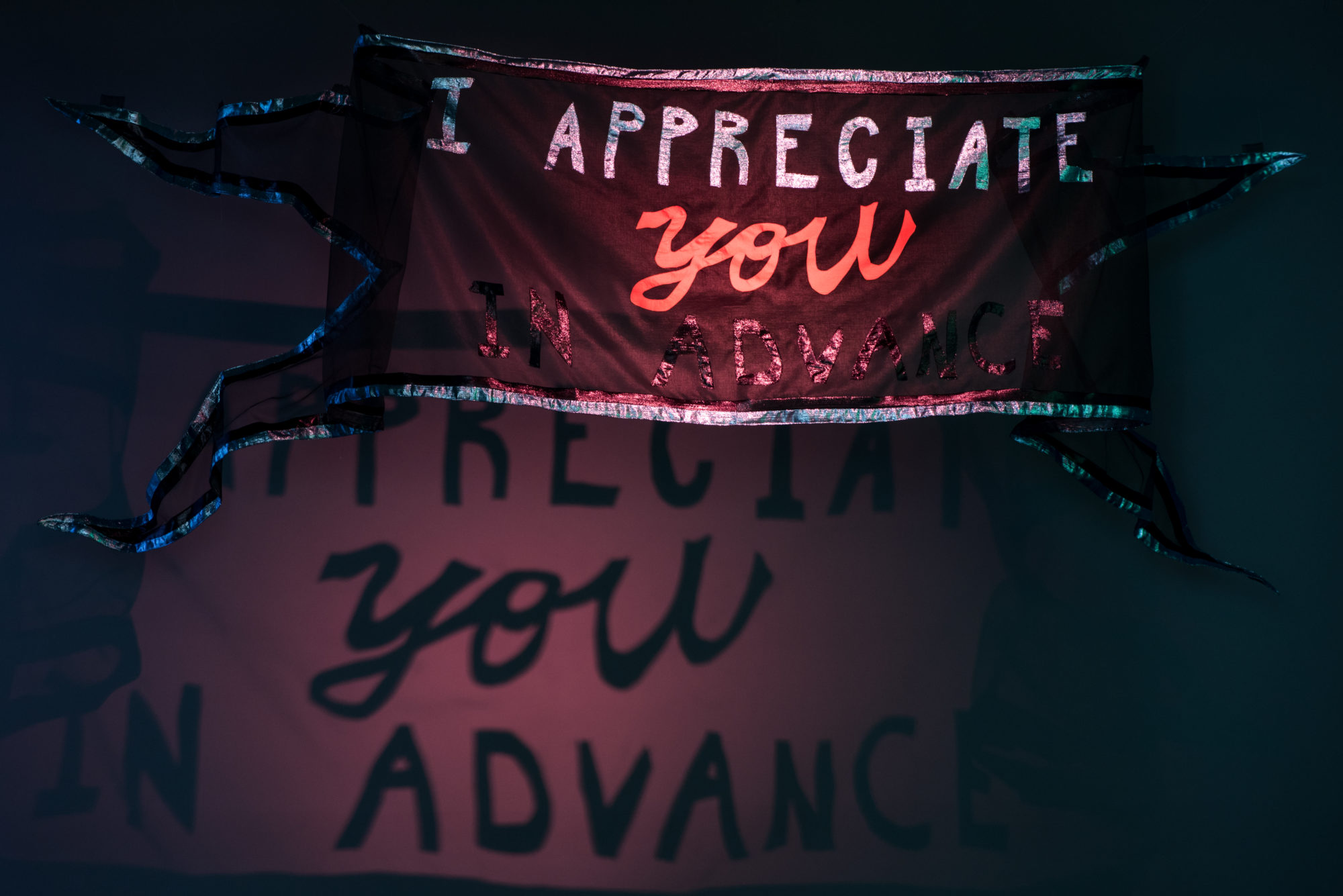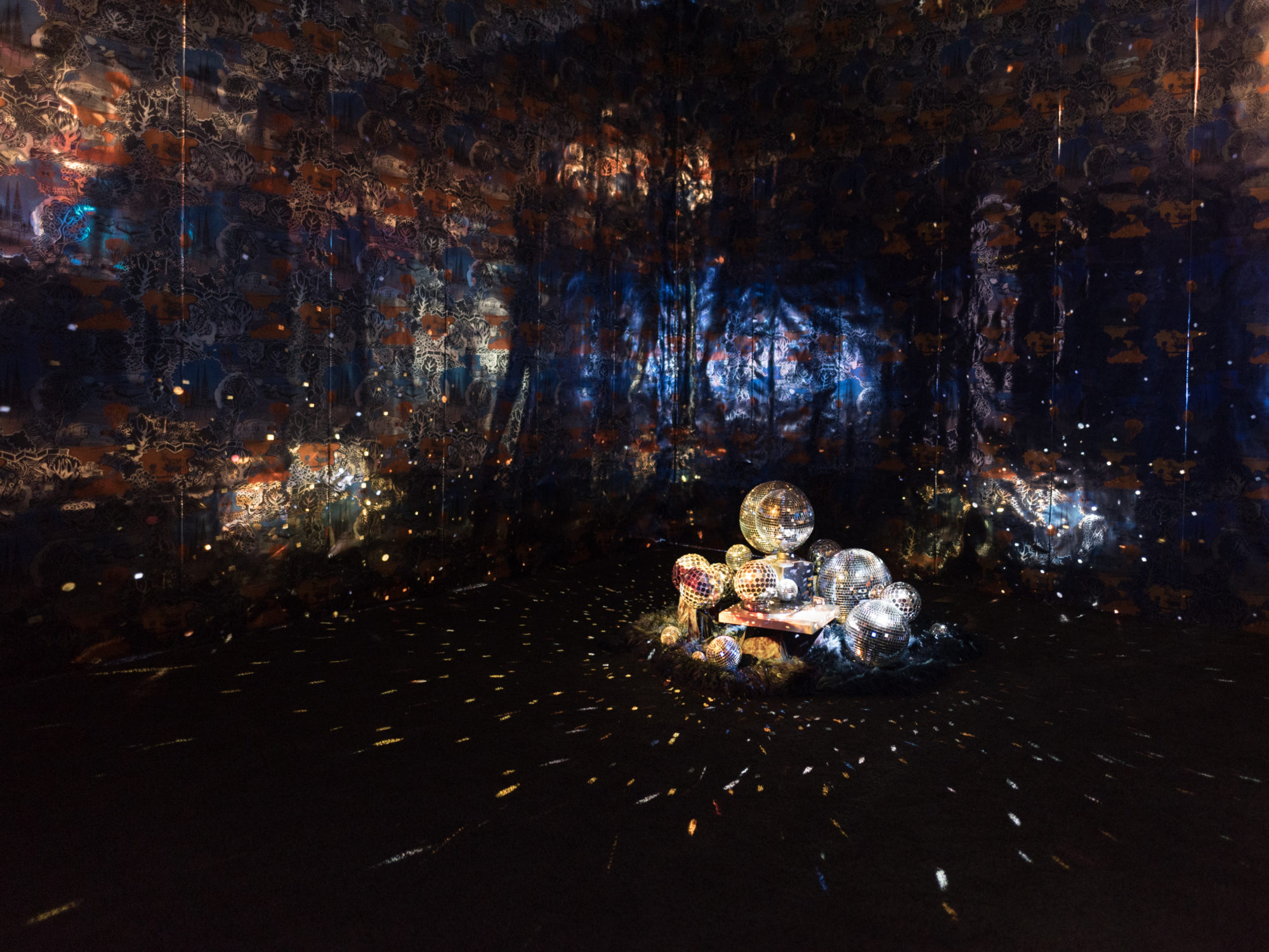Cauleen Smith: Give It or Leave It
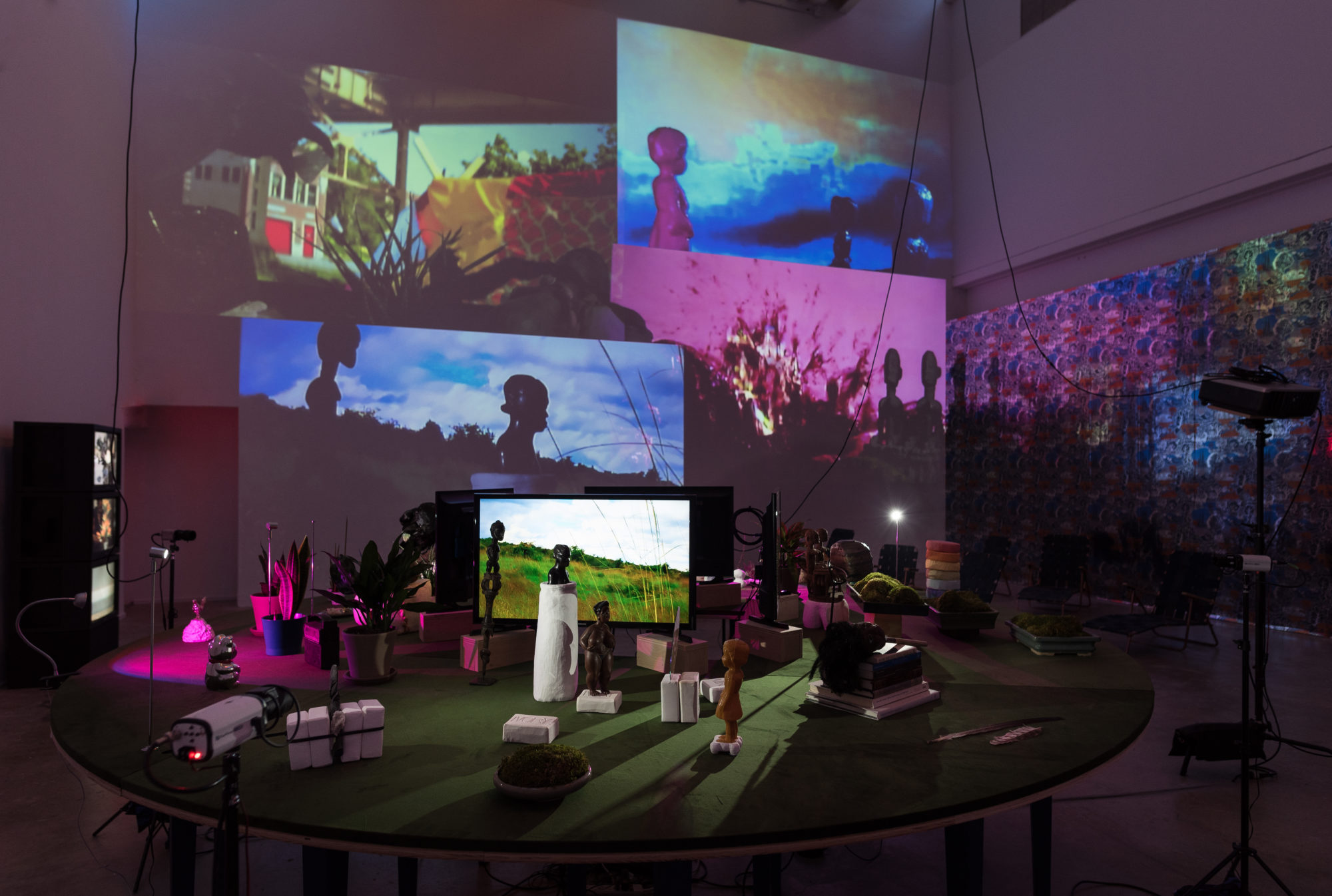
Cauleen Smith, Epistrophe, 2018, multichannel video, color, sound, four CCTV cameras, four monitors, projection, custom wood table, taxidermy raven, wood figures, bronze figures, plastic figures, books, seashells, minerals, jar of starfish, Magic 8-Ball, manekineko, mirror, metal trays, plaster objects, wood objects, wire object, fabric, glass vase, plants [courtesy of the artist and Resnicow and Associates]
Share:
In a political landscape where truth can feel fluid at best and arbitrary at worst, it seems apt that archival discourse is alive and well in the art world zeitgeist. Stars including Zoe Leonard and Danh Vo have reanimated pasts slippery, fictive, and firm to great acclaim in recent years, and institutions continue to bank on under-represented estate acquisitions to catapult untapped Af Klints and Herreras squarely into the heart of art’s historical canon. The “archive” is often characterized as a secret vault where stasis cloaks forgotten things in dark, hushed mystery. Voices might get scrambled or silenced, but their material existence won’t be ignored. Derrida insisted in Archive Fever: A Freudian Impression that “we are all en mal d’archive: in need of archives … a nostalgia for the return to the most archaic place of absolute commencement.” When we look back, we reorient ourselves to the now, to the Real. We can identify glimmers of truth.
Perhaps, then, the archive’s relevance lies in its capacity to inspire hope where hope is not supposed to live. This sense of intrepid buoyancy hummed throughout Cauleen Smith’s beautiful solo exhibition, Give It or Leave It, at ICA Philadelphia. Her lush tableaus transformed just three rooms into a contemplation of the persistence of black American subjectivity, bathing the viewer in a post-historical kaleidoscope of braided narrative and speculation. By mining and recombining ephemera from four separate worlds—Alice Coltrane’s Agoura ashram, Noah Purifoy’s commanding outdoor installations, Bill Ray’s 1966 photo shoot at Simon Rodia’s Watts Towers, and Rebecca Cox Jackson’s 19th-century spiritual testimony—Smith imagines a future that is explicitly black, feminist, and self-consciously splendid, informed but never burdened by the oppression it transcends.
Cauleen Smith, Epistrophe, 2018, multichannel video, color, sound, four CCTV cameras, four monitors, projection, custom wood table, taxidermy raven, wood figures, bronze figures, plastic figures, books, seashells, minerals, jar of starfish, Magic 8-Ball, manekineko, mirror, metal trays, plaster objects, wood objects, wire object, fabric, glass vase, plants [courtesy of the artist and Resnicow and Associates]
California native Smith trained as a filmmaker at UCLA, and structural references to arthouse cinema and anthropological documentation appear throughout Give It or Leave It. The artwork in the entrance space introduces viewers to a frequent visual motif: metallic wallpaper, printed in gold, silver, and plangent blue, depicts the sites explored in Give It or Leave It as an interconnected latticework of languid architectural idylls. Sitting atop this glinting background is a black-and-white photographic print of dapper young black men lounging in an outdoor sculpture park. The image is striking and vaguely familiar; a year after the 1965 Watts Rebellion, one of the era’s bloodiest clashes between black citizens and law enforcement, Life magazine visited the Watts neighborhood with photographer Bill Ray to document the community’s difficulties in the wake of the riots. Many of the Watts: Still Seething snapshots focused on the abject conditions consuming its people—children playing amid rubble, chillingly mundane gang violence—but a subset of Ray’s photos features a throng of sharply dressed black men exploring the Nuestro Pueblo, a sprawling outsider art installation executed over a span of 30 years by Italian immigrant Simon Rodia.
These images feel more like a fashion spread than they do like an exploitation of black pain; in the mosaic-flecked wonderland of the Nuestro Pueblo, Ray’s subjects beam as they interact with their unorthodox surroundings and each other, smiling, striking poses, and surveying the kooky concrete arches around them. By presenting Ray’s photo without its original context or color, Smith simultaneously abstracts and nuances our relationship with its legacy. The men in Smith’s recasting are not victims of circumstance or symbols of insurrection. Instead, their personhood finds new air in the liminal, individualistic space of art brut, fortified by Simon Rodia’s strange paean to escapism. Her creative intervention in black history, far from revisionist in intent, highlights the grace in resilience demanded by hardship to establish a knowingly optimistic framework for Give It or Leave It.
Cauleen Smith, Epistrophe, 2018, multichannel video, color, sound, four CCTV cameras, four monitors, projection, custom wood table, taxidermy raven, wood figures, bronze figures, plastic figures, books, seashells, minerals, jar of starfish, Magic 8-Ball, manekineko, mirror, metal trays, plaster objects, wood objects, wire object, fabric, glass vase, plants [courtesy of the artist and Resnicow and Associates]
Cauleen Smith, Epistrophe, 2018, multichannel video, color, sound, four CCTV cameras, four monitors, projection, custom wood table, taxidermy raven, wood figures, bronze figures, plastic figures, books, seashells, minerals, jar of starfish, Magic 8-Ball, manekineko, mirror, metal trays, plaster objects, wood objects, wire object, fabric, glass vase, plants [courtesy of the artist and Resnicow and Associates]
A floating fiberglass banner, emblazoned in silver ribbon with the words “I Appreciate You In Advance,” casts a formidable shadow along the wall of the first gallery. On the opposite side of the room, a 2017 video, titled Pilgrim, plays on a loop, booming with the rich, thunderous trills of Alice Coltrane’s “Transfiguration” and “One for the Father.” The film splices stuttering footage of Coltrane’s Sai Anantam Ashram in Agoura, CA, with pans of its communal garden, close-ups of Shaker founder Mother Ann Lee’s grave in upstate New York, and lingering shots of two black women wearing white robes and strolling the Ashram’s grounds hand in hand. Coltrane created Sai Anantam after her husband’s sudden death in 1968 left her utterly inconsolable; she hoped other grieving people could find solace in the Eastern tradition of meditation. Fusing post-structuralist form with a dreamy, analogue aesthetic, Smith builds a seven-minute respite for subjects and viewer alike, clandestine, bittersweet, and bright with the promise of healing. A soft ache reverberates from Pilgrim, grounded by healing’s necessarily cruel prerequisites; movements expire, loved ones die. Codas fade into nothingness. The accompanying banner welcomes visitors with expansive generosity, but its ominous, hovering presence reminds us just how rarely that welcome applies to black bodies. As of late November 2018, Sai Anantam was destroyed in California’s recent wildfires. Smith’s ghostly chorus evokes something sharper than nostalgia by gesturing instead at the tandem impossibility and potential in utopia.
Cauleen Smith, I Appreciate You in Advance, 2018, Fiberglass screen, woven metallic polyesters, woven two tone- silk [courtesy of the artist and Resnicow and Associates]
In the next gallery, Smith transmits this atmospheric layering in three dimensions, projecting two complementary works in a single space. Epistrophe (2018) consists of a round, artificial-turf-covered tabletop arrayed with feathers, African sculptures, plants, and piles of tattered paperbacks including Thomas More’s Utopia and black Shaker spiritualist Rebecca Cox Jackson’s autobiography. Four glowing monitors, arrayed in a square, face outward from the table’s center and play scenes of saturated paradise—crashing waves and dripping jungle leaves—behind Smith’s collection of staged objects. Small closed-circuit cameras collapse and project these scenes onto the gallery wall, where inches-tall, static carvings of matriarchs loom large as protagonists in beachside pageants, crackling against scrims with the surreal mendacity of a green-screen. These projections mingle with the nine empty beach chairs of Sky Learns Sky (2018), an installation that places a phantom audience before a stack of 90s television monitors. Three different recordings feature a faceless Smith arranging flowers in real time, recalling the repetitive actions typical of feminist video art in the 60s and 70s. A concerted tension between presence and absence is on display. Objects are personified through hands-free technological mediation, whereas people—the actors, the viewers, the originators—appear only in the contours of their belongings, discarded, arranged, or left behind. Epistrophe and Sky Learns Sky posit art as the bridge between archival recovery and identity politics. While historical remnants of the black experience belie unspeakable horror and iniquity, invention—blues, hip hop, Patois, poetry—provides opportunity for liberatory transformation.
Cauleen Smith, Space Station: Two Rebeccas, 2018, Wallpaper, disco balls, turntable, motor, fur, shag carpet, two projectors, digital video [courtesy of the artist and Resnicow and Associates]
The final room of Give It or Leave It is tight and intense. On one side sits Space Station: Two Rebeccas (2018), a glittering diorama of twirling disco balls foregrounded by Smith’s signature wallpaper. A turntable nestled in a bed of black satin spins the orbs at whiplash speed, bouncing an eerie reflective spray across the darkened space. On an adjacent wall plays Sojourner (2018), a glorious 20-minute black pastoral in video form. Sojourner, a titular reference to the famous abolitionist and the impermanence of pilgrimage, follows a bevy of beautifully adorned black femmes and femmes of color as they strut through Noah Purifoy’s iconic Desert Art Museum of Assemblage Art in Joshua Tree, a post-apocalyptic hinterland populated by found-object sculptures. Purifoy was inspired after witnessing the Watts Rebellion, and many of the Desert Art Museum’s structures were created from charred debris. Another fiberglass sign hangs over the exhibition’s exit, urging visitors to “Afflict the Comfortable and Comfort the Afflicted.” The gallery space itself is cramped, which makes the conceptual density of the installation feel busy rather than sublime, but Smith still achieves a slow-release affectual haze, posing difficult questions. If art is freedom, is freedom a figment? What is the political import of radical speculation? Smith isn’t interested in thesis statements or syllogisms, though. Give It or Leave It takes joy in the process and celebrates the irrepressible beauty in blackness without shrinking from the poignant brevity of celebration itself. Progress might not be linear, but change is inevitable.
This review originally appeared in ART PAPERS Spring/Summer 2019 “Energy Structures”
Torey Akers is an artist and writer based in Brooklyn, NY. Her criticism has appeared in Leste, Two Coats of Paint, Big Red & Shiny, this is tomorrow, and ArtsEditor. She currently works as an Editorial Assistant and contributor to Artspace Magazine.
